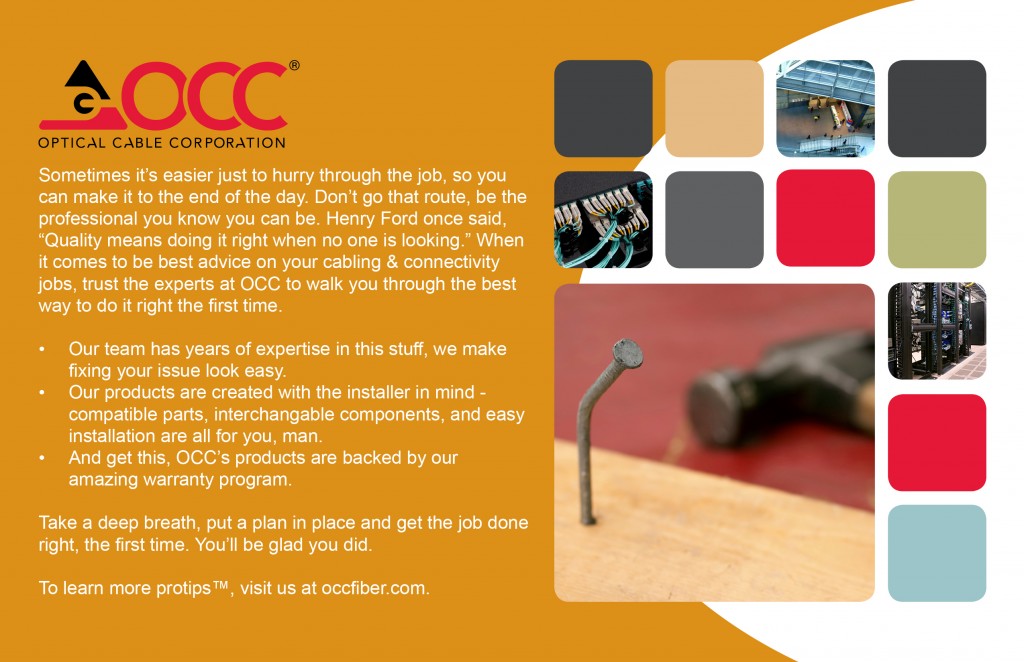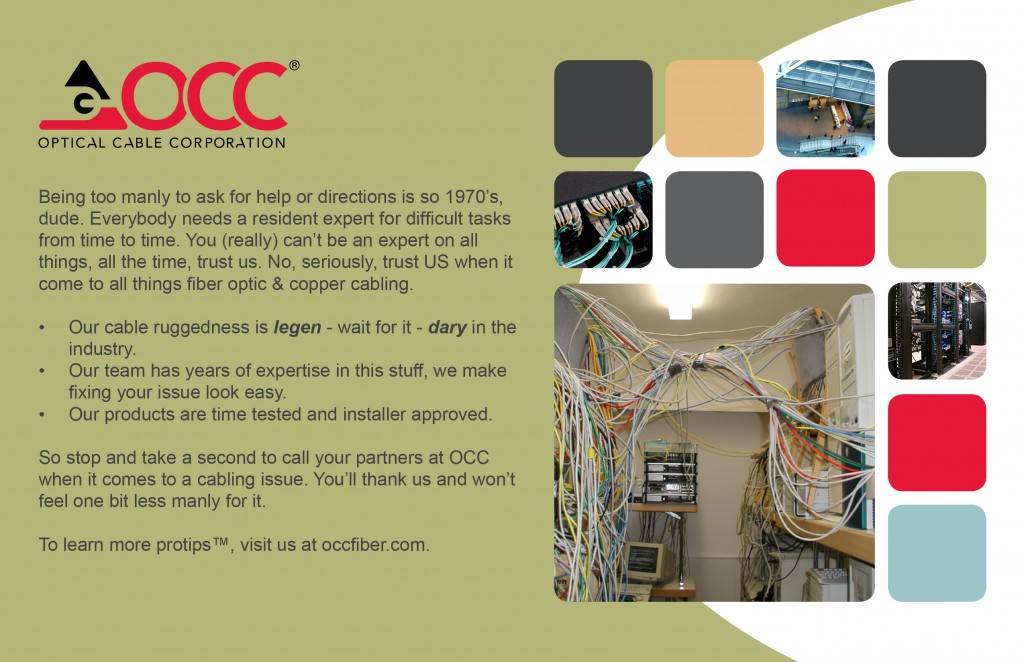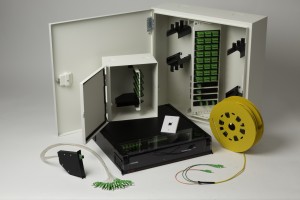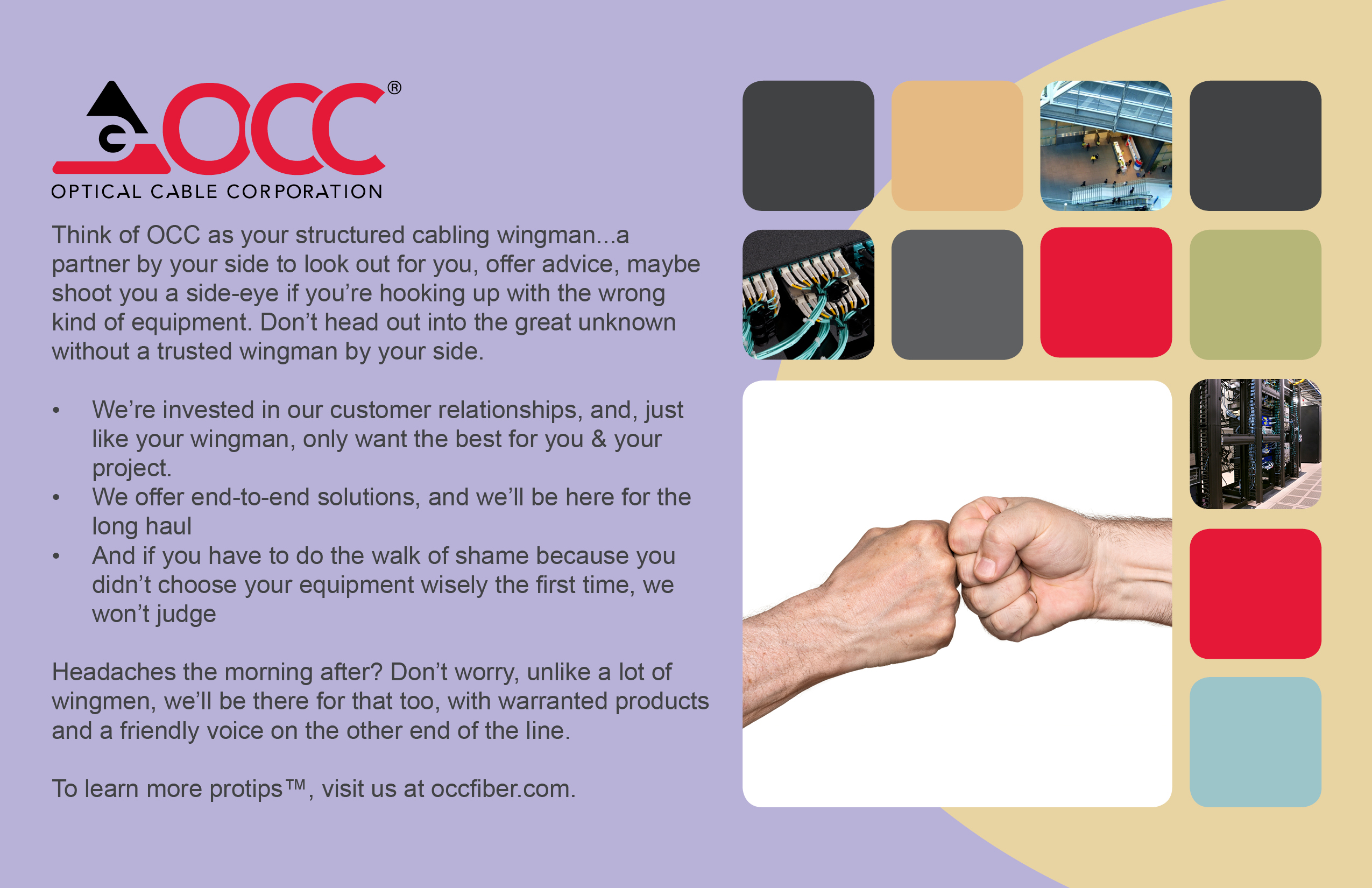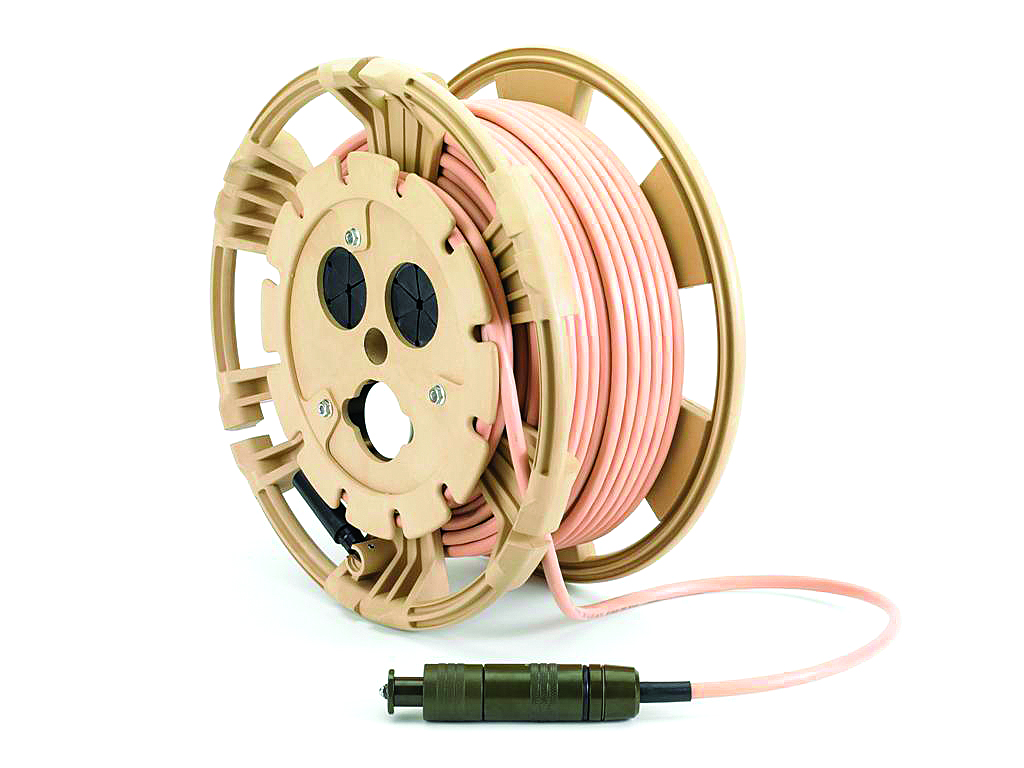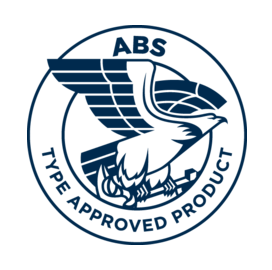You’ve heard of the Bro Code and seen all the different Bro Tips, right? Well, OCC is abiding by the Pro Code and we’d like to share some of our Protips™ that everyone in the structured cabling business should know about!
What you need to know about Passive Optical LAN and OCC’s new line of products
Passive Optical LAN (POL) is a new way to structure a telecommunications network, replacing traditional structured cabling, which consisted of multiple levels of switch and router aggregation.
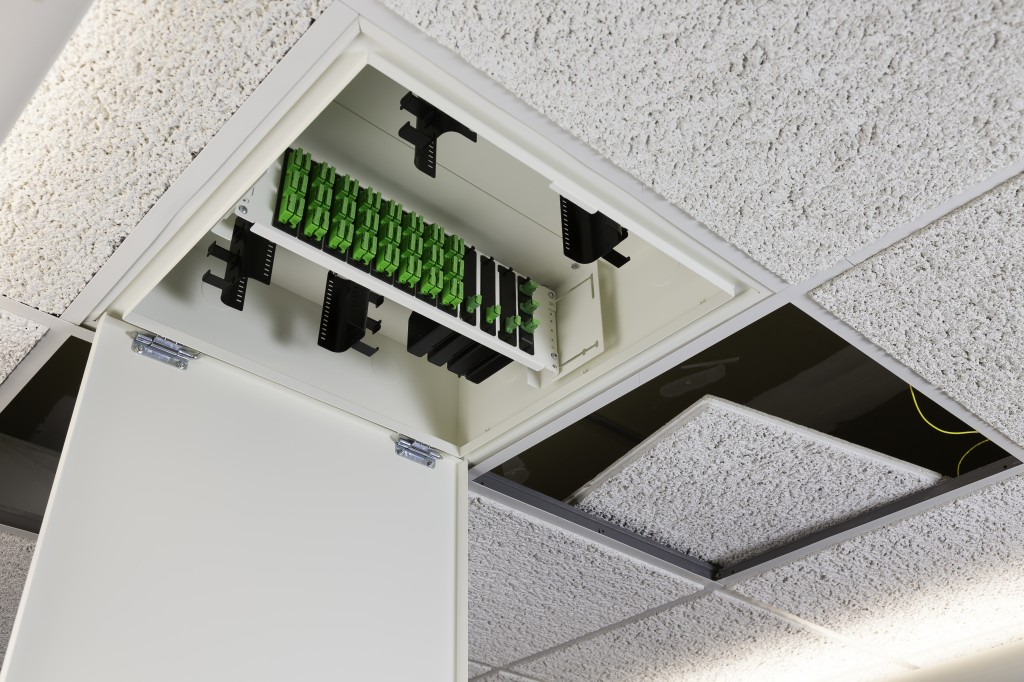
In the traditional model, data was transmitted and dispersed to the desktop through layers of switches, cables and routers. Expanding structured cabling over long distances requires installation of additional switches and routers to carry the signal. This means lots of expensive cable, support infrastructure and labor time.
POL is a more cost effective and energy efficient alternative. POL uses a different architecture with single-mode fiber extended closer to the user and electronic devices that flatten the Local Area Network, eliminating distance constraints and reducing the quantity of cable to the workstations.
A POL consists of an optical line terminal (OLT), an optical splitter, and optical network terminals (ONTs) to transmit voice. An optical splitter splits downstream signals and combines upstream signals to and from the connected devices, all on a single strand of singlemode fiber. Additionally, since the ONTs can support multiple devices, Passive Optical LANs require less cable (and the labor to install it) to support the network.
Benefits of POL:
- Cost savings
- Energy efficient
- Easy install and maintain
- Eliminates need for telecommunications rooms
- Simplifies network moves, adds and changes
- Increased security
OCC has always been known for its tough components and rest assured, the POL Solutions are no different. OCC’s standard multi-fiber and simplex cables provide noteworthy mechanical and environmental performance with greater pull strength, greater impact and crush resistance and bend insensitive fibers. The POL connectivity components are the most resilient on the market
Specifically designed components for the POL easily integrate with all OCC structured cabling fiber optic components providing for a simple installation. OCC offers the best cabling in the industry coupled with service and tailored options, making your choice for a Passive Optical LAN simpler.
Getting Educated on Passive Optical LANs for Colleges and Universities
One of the biggest challenges that colleges and universities face is the ever-increasing demand for bandwidth. With the BYOD mentality that most campuses face today,
the ability to provide easy access to information and to communicate no matter where you are is essential. Campus life no longer dictates reliable Internet service just in the classroom. Now it is required everywhere. As the amount of data and file sizes increase, as well as the need for real-time video and OTA capabilities, the need for increased bandwidth becomes critical. Not to mention the growing need for network and campus security to protect people and property. These increased demands are driving the need for innovative copper and optical fiber cabling technologies that are able to ensure reliable performance and faster data rates.
By implementing a Passive Optical LAN system, higher education facilities can reap the benefits of a streamlined, high-bandwidth network architecture while saving both time and money. Universities cannot afford the downtime associated with rewiring in order to provide greater bandwidth to their students. Passive Optical LAN systems utilize single-mode fiber optic cable. Single-mode fiber optic cable provides the greatest bandwidth compared to any other communications medium available on the market today. At a very economical cost compared to a traditional network infrastructure, Passive Optical LANs minimize the need for future cabling upgrades.
Not only can Passive Optical LANs support telephone, data and video services but they can also service security, building automation systems and wireless services. Other structured cabling solutions necessitate more cables and/or electronics to support the services now required on a modern campus. The added savings of not having to install the necessary plethora of cables to support these additional electronics, shows that Passive Optical LANs are a much more inexpensive solution (both in capital and operational costs), saving the college both up front and year over year costs. And because of the utilization of single-mode fiber, they can expect their investment to payoff for years to come.
OCC’s newly developed Passive Optical LAN takes all those benefits and amplifies them to provide a reliable system that allows for effortless installations. Easy to install and manage, OCC’s POL offers a versatile system that affords substantial improvements in overall CAPEX and OPEX savings as well as streamlines current and future upgrades.
To learn more about OCC’s Passive Optical LAN system, watch this short 2 minute video on all the unique benefits POL has to offer: Click here.
OCC Works with U.S. Military to Solve a “Reel” Problem
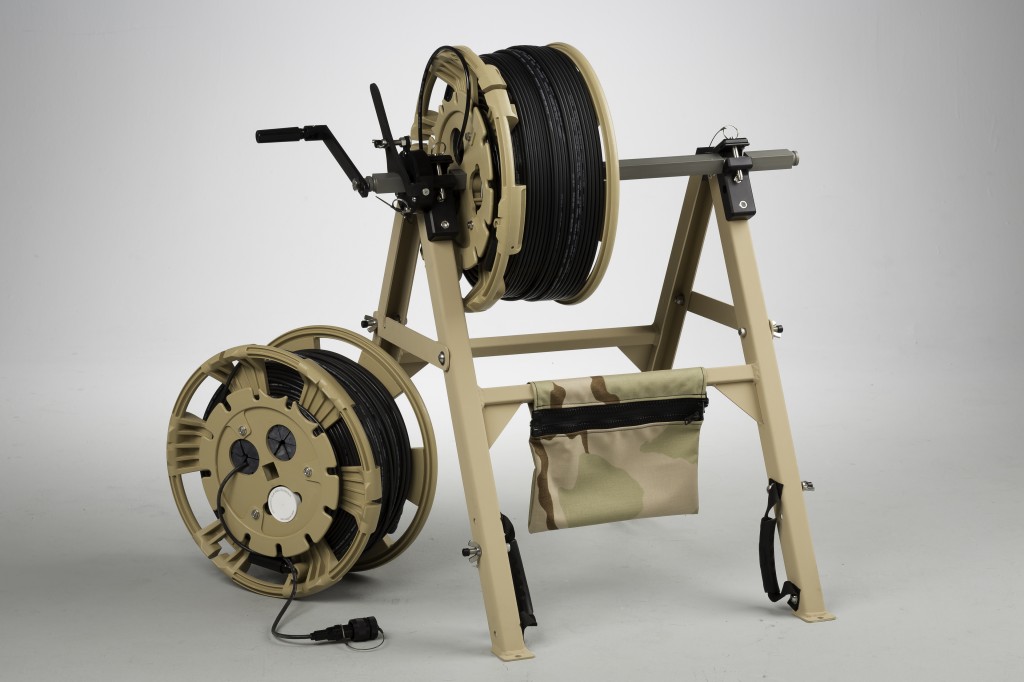
SOLVING COMPLEX PROBLEMS WITH INNOVATIVE PRODUCTS.
AT OCC, IT’S HOW WE THINK.
In the world of military product development, one thing is certain – no one knows more about what new products are needed than the soldiers themselves. When the U.S. Military asked us to take a look at the old RL-31, you can bet we were up to the task. The RL-31 (the military nomenclature for the older style steel reel stand) weighs in at around 60 pounds; they asked us, “Can you do something to make that lighter?”
The soldiers told the OCC team that they often have to carry the RL-31 up rugged terrain in Afghanistan and other places that are not vehicle friendly. Carrying the 60-pound RL-31, along with the extra weight of body armor, backpacks, and weapons is both challenging and risky. The task is hard to perform with much, if any, speed and exposure to enemy fire is always a concern in forward operating areas.
Using modern materials, the initial design prototype weighed in at just 19 pounds – an astounding sixty-six percent reduction in weight. The question was, would it be strong enough and durable enough to perform the mission day in and day out? OCC worked hard to develop realistic environmental and mechanical performance and test requirements that accurately reflected the needs of the modern warfighter. After some initial failures that required strengthening the design, the new reel stand withstood all the punishment that the OCC team could dish out. It was ready to test with the soldiers.
The evaluation team reported that the reel stands performed well in every mission scenario. The team requested a few minor design improvements, which were anticipated. Perhaps the most telling comment of all the feedback was when the team offered to take the evaluation units back with them. The NCO’s smiled and said, “No, we really want to continue training with these.” And of course, we agreed.
TODAY’S OCC. STRONG. INNOVATIVE. SOLUTIONS™.
Making Category 6A Connections Simple
With the exceedingly prevalent use of data, the growth of wireless access points, IP-enabled devices and building automation systems has jumped exponentially. Cameras and other security equipment are now being connected to the network as these devices move from analog to digital or Ethernet based.
This growth has created a need to change the way typical horizontal links and channels are configured for these applications. Devices such as wireless access points mounted in non-traditional locations (in the ceiling or high up on the wall) are not attached to the network using standard faceplate, jack and patch cord configurations. The traditional method is being replaced with direct attachment where the horizontal cable is terminated with a field installable plug and then plugged directly into the equipment.
Currently, installers in the field are utilizing modular plugs that are intended for patch cord construction to terminate Cat5e and Cat6 horizontal cabling. This practice is difficult, time consuming, yields unpredictable performance results and is not recommended by the Telecommunications Industry Association (TIA) 568 standards. Also, these plugs do not accommodate the larger conductors utilized in Cat6A cabling. The increasing data rates of wireless access points and other devices now require a Cat6A cabling link to support 10G Ethernet.
While the TIA-568 communications cabling standard does not currently support direct attach links, the growing demand for field installable plugs has many industry standards such as TIA-862-A, Building Automation Systems Cabling Standard looking to recognize the direct attach method of termination. However, the need for a robust, easy to install field terminable plug for this market segment that provides true performance is imperative.
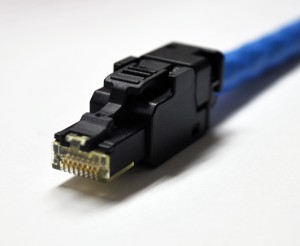
OCC has addressed this need with the introduction of a Category 6A Field Terminable Plug. With OCC’s new plug, terminations are simple and require no specialized tools. They support high-performance 10 Gigabit networks and meet the TIA-568-C.2 Category 6A component performance requirements. In addition, they are supported by OCC’s 25-year MDIS Direct Attach System Performance Warranty when used as an end-to-end OCC copper cabling solution.
For more information about OCC’s Field Terminable Plug, click on the links below:
OCC Harsh Environment Solutions
Typical applications for harsh environment fiber optic cable assemblies in the Oil and Gas market include above-surface (or “top-side”) monitoring and controls for oil and gas rigs, both land and sea based, as well as Geo-seismic exploration equipment. In all cases, the user needs a strong and dependable fiber connection that can be deployed quickly and reliably. Multi-pin hermaphroditic connectors, along with flexible and durable deployable cables manufactured by OCC can be deployed in the most extreme environments where rig operators or exploration teams are working, and all fiber connections can be mated and re-mated with relative ease because of the connectors’ design.
COTS-83526 fiber optic assemblies are widely utilized in the market because multiple manufacturers produce various versions. Often used in deployable military applications, they offer up to 12-channel connectivity with robust and reliable connections in the field for multiple mating cycles. OCC’s COTS-83526 connectors are easily mated to competitor versions, but they offer superior Kevlar retention for better strain relief. OCC’s COTS-83526 connectors can also capture ground wires and cable braids, which are often used by drilling companies for cut resistance, at the receptacle.
EZ-Mate fiber optic cable assemblies offer users up to 24-channel connectivity, and because of their unique design, they can be “blind-mated,” meaning the user can simply twist each end together until they feel the plug mate. Mini Hermaphroditic (MHC-II) fiber optic assemblies offer a similar ease of deployment, but because of their smaller footprint, they can be used in higher-density applications.
Each OCC harsh environment connector utilizes a “physical contact” method of mating fiber channels between termini, and is environmentally sealed for superior mechanical and environmental performance. Their IP-68 rating gives these systems the ability to operate in dirty and wet environments for extended periods of time, and they can easily be cleaned and prepared for re-use if the termini become contaminated in the field. In fact, just like OCC tight-buffered cables, these connectors are designed for use specifically in the dirtiest and wettest of environments and to perform consistently for their users as expected. These connectors are designed to be exposed and survive the oils and chemicals that are likely to be found in oil and gas extraction sites.
Many competitor’s offer expanded beam connectors that mate fiber channels without using a physical contact between termini. Instead, a lens inside the connector expands the light from each fiber channel and sends it over to the corresponding channel on the mated plug or receptacle, where it is refocused and sent into the fiber core. Competitors typically claim these connector systems are better to use in the oil and gas industry because they are easier to clean when they become contaminated. While expanded beam connections are perhaps somewhat easier to clean, they are not very tolerant of dirt or water, including vapor from condensation, rain or fog, being present during operation. In addition, they must be completely dried prior to being placed back in service. In fact, the presence of dirt on a typical expanded beam connection can cause much higher attenuation than similar amounts of dirt on “physical contact” connections like EZ-Mate or COTS-83526. Oily films, constantly present in oil and gas areas, are often difficult to remove from expanded beam lenses. Even fingerprints on lenses can have a negative impact on expanded beam performance. Finally, we have found that expanded beam connectors may not hold up to physical abuse as well as other “physical contact” connectors and are much more susceptible to loss due to shock and vibration, a likely occurrence in seismic exploration applications. Also to note, higher channel counts that allow many fiber links to be connected in one operation generally become very expensive when attempting to use expanded beam.
OCC’s line of hermaphroditic, environmentally sealed connectors and rugged fiber optic cable are ideal for the harsh rigors that fiber optic cable assemblies will experience in the oil and gas industry. Perhaps most important is the fact that OCC offers a vertically integrated solution of cable and connector assemblies for these applications, which means the entire solution can be tailored particularly to an operator’s specific needs.
For more information about OCC harsh environment cable and connectors specifically designed for the Oil & Gas market, contact an OCC Sales Team member – click here.
CASE STUDY: OCC’s Rugged Products Help With Central Valley School District Technology Infrastructure Upgrade
Central Valley School District case study
When Central Valley School District, a K-12 public school system in Spokane Valley, Washington, decided to upgrade their technology infrastructure, they knew they were taking on a large task.
After five years of relatively flat enrollment, the Central Valley schools began to feel the effects of the strengthening economy with back-to-back enrollment increases of more than 200 students for 2 years straight. With more than 12,000 students in 24 school locations across the district, a district-wide retrofit and new infrastructure was necessary to accommodate the growing school system and its technological demands.
The technology infrastructure update was part of a larger June 2012 Capital Facilities Plan initiated by the school district. Initial research for this plan determined that only 8 out of 24 school locations were considered “good with minimal concern” in relation to their Tech/Electrical/Data needs. The school system wanted to fully integrate all aspects of technology including communications, telephone, security and computing into a consistent and unified system across all facilities. These updates included a secure wireless environment with a minimum 10-gigabyte bandwidth to each classroom, a one-to-one ratio for computing devices to students in each building and server capacity to support these networks.
In addition, part of the Capital Facilities Plan required the district-wide installation of access-control and security camera systems to provide additional and increased security measures for students and staff. Cameras were installed at facilities that did not currently have cameras and all district facilities were upgraded with similar camera systems and configurations, for a total of one hundred IP cameras. Additional connect points were installed in anticipation of future camera placements.
Central Valley School District chose Northwest Information Services (NIS) as their engineering consultant. NIS provided the initial in-depth analysis of the physical infrastructure of all the facilities, determining the need for significant upgrades. The NIS team chose Electric Smith, of Spokane, as the contractor to install new copper and fiber cabling within each facility. Optical Cable Corporation’s rugged Cat 6A cabling was ideal for the project’s 850 wireless access points.
One of the challenges faced by the team was completing the installation of this new infrastructure beginning in December of 2013, while school was in session. One of the advantages of OCC’s cabling is its strength and component protection during difficult or tight pulls. Electric-Smith installers were able to navigate the cable pulls through existing areas with minor disruptions to the classrooms.
Once the infrastructure was in place, OCC’s pre-terminated MT cable assemblies and cassettes were used to ensure reliable performance with streamlined connectivity. Their sturdy constructions held up well during the installation around existing spaces and once installed, were easy to test. Additionally, a number of OCC’s other products were chosen for this project including rack mount fiber panels, Cat 6A patch panels, jacks, OM3 MT assemblies and cassettes. Using the easy to install, pre-terminated MT assemblies and cassettes allowed for significant labor cost savings.
Sources:
https://www.cvsd.org/documents/Public_Information/Facilities/2014-04-FocusFacilities.pdf
https://www.cvsd.org/documents/Public_Information/Facilities/Capital%20Facilities%20Plan-Approved%20Plan-June%202010%20%282%29.pdf
MARS Reel line earns Nato/National Stock Number (NSN)
OCC’s MARS cable reels are the industry’s first lightweight cable deployment reel system designed specifically for the demanding needs of harsh-environment fiber optic installations. The MARS reel is a lightweight, modular system constructed of an impact modified polymer that is easily transported and is ideal for applications where cable needs to be deployed and retrieved quickly and stored efficiently.
The MARS reel system has recently been issued National Stock Numbers (NSN’s) from the United States Defense Logistics Agency (DLA). The NSN indicates a review and approval for use within the military’s logistics supply chain. US military services, the Department of Defense (DoD), disposition services, federal agencies (such as GSA, FAA, DHS, etc.), the North Atlantic Treaty Organization (NATO), and many governments around the world use NSNs. To achieve this status, the MARS reels underwent strict qualification testing to the U.S. Army CECOM Specification A336463A, resulting in the following:
• Performance: The cable reel stores and allows for the deployment and retrieval of fiber optic cable assemblies in a variety of environmental and mechanical conditions without damaging or affecting performance of these assemblies.
• Materials: The reel flanges are made from light-weight, durable, and non-porous material that meets the fiber optic cable assembly requirements specified in CECOM drawings A3159863, A3159864, and A3302584. The flanges and handles, excluding the attached
hardware and drum, are fabricated from non-conductive materials. All parts are non-rusting.
• Finish: Colors include, but not limited to, Black, (Desert) Tan 33446 and Olive Drab 34088 as identified in table 3 of FED-STD-595. The finish is lusterless, non-reflective, and fade-resistant.
• Field Transportable: The reel is designed to enable ease of transport by grasping the flange frame at multiple points with a single bare or gloved hand.
• Connector Storage: The reel is capable of securely storing fiber optic connectors within the drum of the reel without need for tools for removal or storage of the connectors.
• Operation: The reel design easily supports deployment or retrieval of fiber optic cable in either manual or automated modes. A folding handle is available for manual cable retrieval. The modular design allows operation on a simple axle or with any number of cable reel accessories. MARS accommodates either round or square drive acles and reeling machines.
• Stacking: The reels are capable of being vertically stacked securely to a height of 5 feet without deforming, distorting or damaging any of the reels.
• Testing: Operating Temperature, Storage Temperature, Temperature – Humidity Cycling, Cold Drop Test, Flammability and Vibration
In addition to meeting the specification requirements in CECOM’s A336463A, the MARS reels underwent user evaluation by the U.S. Army Signal School at Fort Gordon, Georgia in 2012 to determine if the product could withstand day-to-day use. Signal classes utilized the reel for communications exercises as well as conducted their own endurance and confidence testing. The Signal School evaluators offered high praise for significant weight reduction and increased ruggedness and durability over standard steel reels. The MARS reels are currently specified on multiple U.S. Army and Marine Corps cable assembly drawings and specifications. With the assignment of NSN’s to the MARS family of reels, U.S. and allied defense agencies will be able to specify and acquire the specific model of reel or reels required to satisfy their mission requirements.

